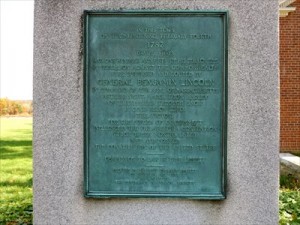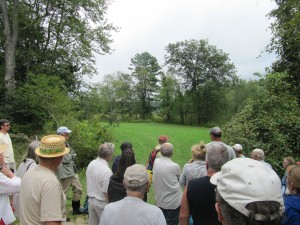
On a cold Sunday morning in February 1787, several thousand soldiers at the end of a brutal march through a blizzard surprised a sleeping army encamped in the center of Petersham and routed them quickly, all but ending an armed uprising by farmers in the central and western parts of the state. Just to the south was the farm of Benjamin Chandler, who had come to Petersham from Westford. We don’t know exactly when Chandler moved to town or where he stood on the politics of the “Regulation,” as Shays’s Rebellion was known to many. But we do know something of the subsequent history of his farm, including its recent purchase by young farmers who were able to leverage support from emerging models of land stewardship designed to keep farmland in production.
The two events are distant in time, but there’s a thread connecting the 18th century fight with the 21st century sale. At bottom, both were responses to a fundamental problem in American farming: having a farm doesn’t necessarily equate to having enough capital for a farmer to stay afloat in a market-oriented economy.
First, some of the big picture. Historically, food and land in Massachusetts have become commodified—that is, their financial value became determined entirely by market-oriented considerations—along very different paths. In this part of the U.S., land has been in limited supply for a very long time. As far back as the colonial period, there wasn’t enough arable land in Massachusetts for everyone who wanted to farm it, and by the time of the Revolution, many farmers—like Chandler—were moving into less-fertile areas like the central and western Massachusetts hill towns.
The value of land has of course risen and fallen with economic ups and downs, and there have been times—for example, during the Great Depression of the 1930s—when it was possible for new farmers to find affordable land in central Mass. But by then, the region’s agricultural economy had been struggling for many decades with the fact that food was being produced on much larger farms elsewhere, creating economies of scale that made it steadily more difficult for small New England farms to compete. As a commodity, industrially-produced food has gotten steadily cheaper, to the point that Americans spend proportionately less than anyone else in the world on what they eat (under 10% of disposable income, on average).

Area farmers have historically found many ways to adapt and cope. They’ve shifted to dairy and fruit production, formed cooperative organizations, courted tourists and sold some of their land for residential development. But as the 20th century went on, and especially after the rise of interstate highways, long-distance refrigerated trucking, and supermarket chains after World War II, small farmers in this part of the world found themselves stuck in a financial squeeze that is far from resolved today. Without the benefit of those economies of scale, individual small farmers can’t hope to compete on price. A small farmer paying a hefty mortgage has even less chance of breaking even, let alone making any kind of profit.
It is, in fact, the very same dilemma that Daniel Shays and his “Regulators” were attempting to regulate: the balance between the demands of a capital-oriented economy and the realities of making a living from the land. So to bring things back down to the local scale: Does the recent purchase of the old Chandler Farm in Petersham by Emily Anderson and Tyson Neukirch suggest a new approach to this long-standing predicament?

Emily, a Petersham native, and Tyson, a Nebraskan who learned organic farming in Oregon and California and now teaches at The Farm School in Athol, are part of a rising generation of young farmers who see themselves contributing to a deep rethinking of how and why we farm. Living on a two-acre property, they wanted to broaden their agricultural presence in the town while remaining close to its center. That’s a tall order in Petersham, where large parcels seldom come up for sale and are far from affordable when they do.
But the former Chandler Farm, which passed through ownership by Chandler descendants and others in the LePoer and King families by the mid-20th century, presented a unique opportunity—if they could put together the capital to buy the land at a price that wouldn’t prevent them from ever making a living from it. The land was owned by Gil and Linda King, who kept its central open area—the only prime agricultural land in the 106-acre parcel—as a hayfield but had not cultivated it otherwise. The Kings had already put the farm on the open market, but readily took it off again when Emily and Tyson approached them with a proposal for a somewhat different kind of sale.
That proposal was based on another kind of big picture: one that considers the resources of a town or a region much more holistically and asks how they can fit together to support human sustenance and livelihood, species and habitat biodiversity, carbon sequestration, water and air quality, and a “sense of place” shared and appreciated by residents and visitors alike. As at Chase Hill Farm in Warwick, public and private entities joined forces to facilitate the sale and protect the land.

Seeing a chance to provide access to town-owned conservation land, among other benefits, Petersham’s Conservation Commission quickly updated its Open Space and Recreation plan as a step toward applying for grants through the state’s Executive Office of Energy and Environmental Affairs and the Quabbin to Cardigan Partnership, a regional landscape conservation effort of which Petersham is a southern terminus. The East Quabbin Land Trust assisted with grant applications and private fundraising, demonstrating the role that land trusts are increasingly playing in filling the gaps in what individuals and public agencies can do. (An article about EQLT’s role can be found on page 3 of this newsletter.) And the Kings themselves, along with local realtor Chuck Berube, were key partners, willing to forego the relative simplicity of a traditional sale in order to work with buyers who had a compatible vision of the farm’s place within its social and environmental ecosystems.
One big difference from the Chase Hill Farm conservation process was that this was not a matter of expanding an existing farm operation but establishing a new one with a young farm family (Emily and Tyson have three children). The average age of American farmers continues to rise while their numbers continue to dwindle, and despite the much-heralded turn toward local and small-scale agriculture over the past decade, the most recent Agricultural Census, completed in 2012, shows a considerable drop in the number of new farmers in the previous five years. While opinions differ on whether this indicates a crisis in the making, it does raise important questions, and advocacy groups like the National Young Farmers Coalition have identified access to land as one of the main obstacles that entry-level farmers face.
Unlike those who tend to demonize the industrial food system, Tyson’s upbringing on a conventional corn and soybean farm has given him an understanding of how large-scale farmers, too, are caught in a system where the costs of operation and the prices of products are too often out of sync. Noting that tax codes and subsidy systems practically dictate that farmers stay on the treadmill of expansion and high-input methods, he says, “Those are not ideas conceptualized by an agrarian society. Those are the ways an agricultural system interacts with the larger economic one.” It’s essential, he argues, “to separate the speculative value of land relative to its agricultural value.”
The vision for the future of this farm goes further, upending the usual focus to put the capacities and limitations of the land itself at the center. “This is all an experiment,” says Tyson. “The exciting thing is that I think as we shift our understanding of what agriculture is and what a farm really is, we also begin to understand that the products that a farm is able to produce are going to change and evolve over time, hopefully not based just solely on what the consumer demands are, because that’s how we’re driven right now, but what the ecological system needs of the farm itself are.”
It’s a vision that nods toward the small scale on which the “Regulators” of 1787 necessarily practiced agriculture. But Tyson is far from romantic about those older modes of farming, which he describes as “by no means restorative or resilient.” Noting the inherent limitations of the King Farm, with its “little island” of prime soil in the midst of a rocky and forested terrain, he asks, “How can we work with these types of landscapes to make them both ecologically resilient and also economically productive? I think it’s going to take some different perceptions of what agriculture is to be able to make that a reality.”
One thought on “The big picture: The King farm in Petersham”